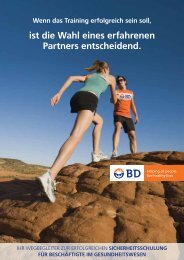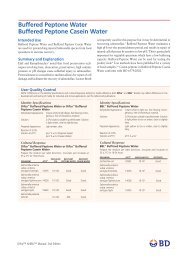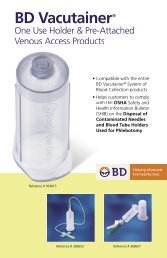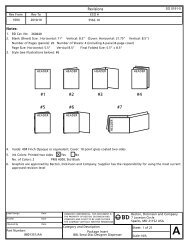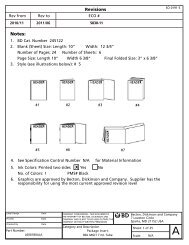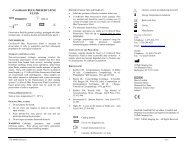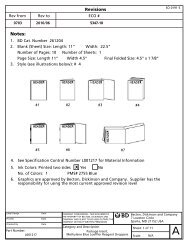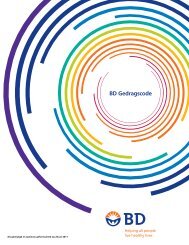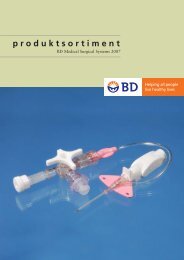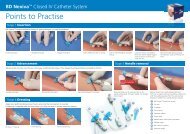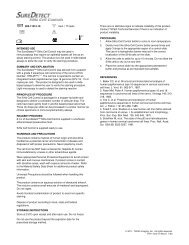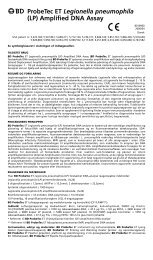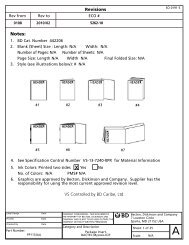BBL™ Bacteroides Bile Esculin Agar (BBE) and BBL™ CDC ... - BD
BBL™ Bacteroides Bile Esculin Agar (BBE) and BBL™ CDC ... - BD
BBL™ Bacteroides Bile Esculin Agar (BBE) and BBL™ CDC ... - BD
You also want an ePaper? Increase the reach of your titles
YUMPU automatically turns print PDFs into web optimized ePapers that Google loves.
BBL <strong>Bacteroides</strong> <strong>Bile</strong> <strong>Esculin</strong> <strong>Agar</strong> (<strong>BBE</strong>) <strong>and</strong><br />
BBL <strong>CDC</strong> Anaerobe Laked Sheep Blood <strong>Agar</strong> with KV - I Plate<br />
8801811 • Rev. 02 • August 2011<br />
QUALITY CONTROL PROCEDURES<br />
I INTRODUCTION<br />
<strong>Bacteroides</strong> <strong>Bile</strong> <strong>Esculin</strong> (<strong>BBE</strong>) <strong>Agar</strong> is used as a primary isolation medium for the selection <strong>and</strong> presumptive identification of the<br />
B. fragilis group.<br />
<strong>CDC</strong> Anaerobe Laked Sheep Blood <strong>Agar</strong> with Kanomycin <strong>and</strong> Vancomycin (KV) is an enriched, selective culture medium for the<br />
selective isolation of obligately anaerobic gram-negative bacilli from clinical <strong>and</strong> nonclinical materials.<br />
II PERFORMANCE TEST PROCEDURE<br />
A. <strong>Bacteroides</strong> <strong>Bile</strong> <strong>Esculin</strong> <strong>Agar</strong><br />
1. Reduce all plates overnight at room temperature in a <strong>BD</strong> GasPak EZ anaerobic system.<br />
2. Inoculate representative samples with the cultures listed below.<br />
a. For obligate anaerobes, streak inoculate with 1 µL (0.001 mL) from a 48 – 72 h culture of Chopped Meat Broth that has<br />
incubated for 2 days at 35 – 37°C.<br />
b. For E. coli <strong>and</strong> P. mirabilis streak inoculate with 1 µL (0.001 mL) from a 4 – 5 h culture of Trypticase Soy Broth.<br />
c. Incubate plates at 36 ± 1°C in an anaerobic atmosphere.<br />
d. Include plates of a previously tested lot of TSA with 5% Sheep Blood as controls for all strains.<br />
3. Examine plates after 48 h for growth, esculin hydrolysis <strong>and</strong> selectivity.<br />
4. Expected Results<br />
Organisms ATCC Recovery <strong>Esculin</strong> Reaction<br />
*<strong>Bacteroides</strong> fragilis 25285 Fair to heavy growth + (blackening)<br />
<strong>Bacteroides</strong> ovatus 8483 Fair to heavy growth + (blackening)<br />
<strong>Bacteroides</strong> thetaiotaomicron 29741 Fair to heavy growth + (blackening)<br />
*<strong>Bacteroides</strong> vulgatus 8482 Fair to heavy growth +/– (may or may not produce blackening)<br />
*Clostridium perfringens 13124 No growth N/A<br />
Escherichia coli 25922 No growth N/A<br />
*Proteus mirabilis 12453 No growth to trace growth N/A<br />
*Recommended organism strain for User Quality Control.<br />
NOTE: This medium is exempt from User QC testing according to CLSI M22-A3.<br />
B. <strong>CDC</strong> Anaerobe Laked Sheep Blood <strong>Agar</strong> with KV<br />
1. Inoculate representative samples with the cultures listed below.<br />
a. For obligate anaerobes, streak inoculate with 1000 – 10,000 CFU from a 0.5 McFarl<strong>and</strong> st<strong>and</strong>ard Enriched Thioglycollate<br />
Medium (ETM) with Vitamin K 1 <strong>and</strong> Hemin. Use a 48 – 120 h <strong>CDC</strong> Anaerobe with 5% Sheep Blood culture to inoculate the<br />
ETM.<br />
b. For E. coli <strong>and</strong> S. aureus, use a 1:10 dilution of an 18 – 24 h Trypticase Soy Broth culture.<br />
c. For P. mirabilis use a 1:1000 dilution of an 18 – 24 h Trypticase Soy Broth culture.<br />
d. Incubate plates at 36 ± 1°C in an anaerobic atmosphere.<br />
e. Include plates of a previously tested lot of TSA with 5% Sheep Blood as controls for all strains.<br />
2. Examine plates after 48 h for growth, color formation, fluorescence <strong>and</strong> selectivity.<br />
3. Expected Results<br />
Organisms ATCC Recovery Colony Color Fluorescence †<br />
*<strong>Bacteroides</strong> fragilis 25285 Moderate to heavy growth Gray –<br />
Porphyromonas levii 29147 Moderate to heavy growth Tan to brown-black +<br />
*Clostridium perfringens 13124 No growth N/A –<br />
*Fusobacterium mortiferum 25557 Fair to heavy growth Off-white to yellow-tan –<br />
Porphyromonas asaccharolytica 25260 Moderate to heavy growth Brown-black +<br />
Prevotella intermedia 25611 Moderate to heavy growth Tan-medium brown +<br />
Escherichia coli 25922 Inhibited Gray –<br />
*Proteus mirabilis 12453 Inhibited Light gray –<br />
Staphylococcus aureus 25923 No growth N/A N/A<br />
*Recommended organism strain for User Quality Control.<br />
† Examine colonies on the <strong>CDC</strong> media with a long-wave (365 nm) UV lamp. Colonies of the pigmenting Porphyromonas-Prevotella species should<br />
fluoresce orange to brick red under UV light. Fluorescence is visible before pigmentation. Fluorescence is seen only in young colonies. Pigment<br />
develops slowly <strong>and</strong> may obscure fluorescence.<br />
NOTE: This medium is exempt from User QC testing according to CLSI M22-A3. However, monitoring of exempt media used for anaerobes is<br />
strongly recommended.<br />
8801811 1 of 4
III ADDITIONAL QUALITY CONTROL<br />
1. Examine plates as described under “Product Deterioration.”<br />
2. Visually examine representative plates to assure that any existing physical defects will not interfere with use.<br />
3. Determine the pH potentiometrically at room temperature for adherence to the specification of 7.0 ± 0.2 (<strong>Bacteroides</strong> <strong>Bile</strong><br />
<strong>Esculin</strong> <strong>Agar</strong>) <strong>and</strong> 7.5 ± 0.2 (<strong>CDC</strong> Anaerobe Laked Sheep Blood <strong>Agar</strong> with KV).<br />
4. Note the firmness of plates during the inoculation procedure.<br />
5. Incubate uninoculated representative plates at 35 ± 2°C for 72 h <strong>and</strong> examine for microbial contamination.<br />
PRODUCT INFORMATION<br />
IV INTENDED USE<br />
These media are used in qualitative procedures for the isolation <strong>and</strong> cultivation of obligately anaerobic microorganisms from<br />
clinical <strong>and</strong> nonclinical specimens.<br />
These media in two-sectored I Plate dishes offer the ability to utilize the properties of the two media in one plate.<br />
V SUMMARY AND EXPLANATION<br />
The members of the <strong>Bacteroides</strong> fragilis group are among the most frequently encountered anaerobes in human clinical<br />
infections. Rapid detection <strong>and</strong> identification of these organisms is important, since they tend to be more resistant to<br />
antimicrobial therapy than other anaerobes. 1,2 B. fragilis <strong>and</strong> B. thetaiotaomicron are the species of greatest clinical<br />
significance. 1 Other species in the group are: B. caccae, B. distasonis, B. eggerthii, B. merdae, B. ovatus, B. stercoris, B. uniformis<br />
<strong>and</strong> B. vulgatus.<br />
<strong>BBE</strong> was developed by Livingston et al. as a primary plating medium. 3 This medium provides selective recovery of the B. fragilis<br />
group <strong>and</strong> also evidence for presumptive identification based on esculin hydrolysis. 3<br />
<strong>CDC</strong> Anaerobe Blood <strong>Agar</strong> was developed at the Centers for Disease Control <strong>and</strong> Prevention as a nonselective medium for<br />
the isolation <strong>and</strong> cultivation of a wide variety of obligately anaerobic microorganisms, particularly those found in clinical<br />
materials. 4,5<br />
The addition of the antimicrobial agents kanamycin <strong>and</strong> vancomycin enables the selective isolation of gram-negative,<br />
nonsporeforming anaerobic bacilli, particularly Porphyromonas <strong>and</strong> Prevotella species. 4,6<br />
<strong>CDC</strong> Anaerobe Laked Sheep Blood <strong>Agar</strong> with KV consists of <strong>CDC</strong> Anaerobe Blood <strong>Agar</strong> base supplemented with laked sheep<br />
blood, kanamycin <strong>and</strong> vancomycin.<br />
VI PRINCIPLES OF THE PROCEDURE<br />
<strong>BBE</strong> is a primary plating medium for the selective isolation <strong>and</strong> presumptive identification of the B. fragilis group. Selective<br />
inhibition of facultative anaerobes <strong>and</strong> most gram-negative anaerobes is obtained by the presence of gentamicin <strong>and</strong> oxgall. 1,7<br />
Differentiation of the B. fragilis group is based on esculin hydrolysis. Hydrolysis of the esculin by members of the B. fragilis<br />
group produces esculetin <strong>and</strong> glucose. The esculetin reacts with the iron salt contained in the medium to produce a dark brown<br />
to black complex that appears as zones around the colonies of organisms that hydrolyze eculin.<br />
<strong>CDC</strong> Anaerobe 5% Sheep Blood <strong>Agar</strong> consists of BBL Trypticase Soy <strong>Agar</strong> enriched with yeast extract to supply vitamins,<br />
amino acids <strong>and</strong> other essential nutrients. The medium is further enriched with hemin <strong>and</strong> vitamin K 1 to supply nutrients that<br />
are required by some strains of the pigmenting Porphyromonas-Prevotella (formerly <strong>Bacteroides</strong>) species <strong>and</strong> are reported<br />
to enhance the growth of some other species <strong>and</strong> some gram-positive nonsporeforming anaerobes. 5,8,9 Defibrinated sheep<br />
blood is added to supply nutrients <strong>and</strong> for the determination of hemolytic reactions <strong>and</strong> pigmentation. The use of laked blood<br />
improves the pigmentation of the Prevotella <strong>and</strong> Porphyromonas species. 6<br />
Kanamycin <strong>and</strong> vancomycin inhibit most gram-positive facultative <strong>and</strong> obligate anaerobic microorganisms. 7<br />
VII REAGENTS<br />
<strong>Bacteroides</strong> <strong>Bile</strong> <strong>Esculin</strong> <strong>Agar</strong> (<strong>BBE</strong>)<br />
Approximate Formula* Per Liter Purified Water<br />
Pancreatic Digest of Casein...........................................14.5 g Hemin......................................................................................0.01 g<br />
Papaic Digest of Soybean Meal ......................................5.0 g Gentamicin .............................................................................0.1 g<br />
Sodium Chloride ..............................................................5.0 g Vitamin K 1 ..............................................................................0.01 g<br />
<strong>Esculin</strong>...............................................................................1.0 g <strong>Agar</strong> ..................................................................................... 14.0 g<br />
Ferric Ammonium Citrate................................................0.5 g Growth Factors.......................................................................1.8 g<br />
Oxgall .............................................................................15.0 g<br />
*Adjusted <strong>and</strong>/or supplemented as required to meet performance criteria.<br />
<strong>CDC</strong> Anaerobe 5% Sheep Blood <strong>Agar</strong><br />
Approximate Formula* Per Liter Purified Water<br />
Pancreatic Digest of Casein........................................... 15.0 g Hemin................................................................................... 0.005 g<br />
Papaic Digest of Soybean Meal ...................................... 5.0 g Vitamin K 1 ........................................................................... 0.01 g<br />
Sodium Chloride .............................................................. 5.0 g L-Cystine............................................................................... 0.4 g<br />
<strong>Agar</strong> ................................................................................ 20.0 g Sheep Blood, defibrinated ................................................. 5%<br />
Yeast Extract..................................................................... 5.0 g<br />
*Adjusted <strong>and</strong>/or supplemented as required to meet performance criteria.<br />
<strong>CDC</strong> Anaerobe Laked Sheep Blood <strong>Agar</strong> with KV consists of <strong>CDC</strong> Anaerobe Blood <strong>Agar</strong> base with 5% laked defibrinated sheep<br />
blood, 100.0 mg/L kanamycin <strong>and</strong> 7.5 mg/L vancomycin.<br />
Warnings <strong>and</strong> Precautions: For in vitro Diagnostic Use.<br />
If excessive moisture is observed, invert the bottom over an off-set lid <strong>and</strong> allow to air dry in order to prevent formation of a<br />
seal between the top <strong>and</strong> bottom of the plate during incubation.<br />
Storage Instructions: On receipt, store plates in the dark at 2 – 8°C. Avoid freezing <strong>and</strong> overheating. Do not open until ready<br />
to use. Minimize exposure to light. Prepared plates stored in their original sleeve wrapping at 2 – 8°C until just prior to use<br />
8801811 2 of 4
may be inoculated up to the expiration date <strong>and</strong> incubated for recommended incubation times. Allow the medium to warm to<br />
room temperature before inoculation.<br />
Product Deterioration: Do not use plates if they show evidence of microbial contamination, discoloration, drying, cracking or<br />
other signs of deterioration.<br />
VIII SPECIMEN COLLECTION AND HANDLING<br />
Refer to appropriate texts for details of specimen collection <strong>and</strong> h<strong>and</strong>ling procedures. 1,2,5,10,11<br />
Observe established precautions against microbiological hazards throughout all procedures. All specimens should be h<strong>and</strong>led<br />
according to <strong>CDC</strong>-NIH recommendations, CLSI guidelines or local institution guidelines for any potentially infectious human<br />
serum, blood or other body fluids. Prior to discarding, sterilize specimen containers <strong>and</strong> other contaminated materials by<br />
autoclaving.<br />
IX PROCEDURE<br />
Material Provided: <strong>Bacteroides</strong> <strong>Bile</strong> <strong>Esculin</strong> <strong>Agar</strong> // <strong>CDC</strong> Anaerobe Laked Sheep Blood <strong>Agar</strong> with KV - I Plate<br />
Materials Required But Not Provided: Ancillary culture media, reagents, quality control organisms <strong>and</strong> laboratory equipment as<br />
required.<br />
Test Procedure: Observe aseptic techniques.<br />
The agar surface should be smooth <strong>and</strong> moist, but without excessive moisture.<br />
These media should be reduced immediately prior to inoculation by placing them under anaerobic conditions for 6 – 24 h. 12<br />
Inoculate the medium as soon as possible after the specimen arrives at the laboratory. To culture a specimen from a swab,<br />
inoculate the medium by rolling the swab over a third of the agar surface, <strong>and</strong> streak the remainder of the plate to obtain<br />
isolated colonies. Material not being cultured from swabs should be streaked onto the medium with a sterilized inoculating<br />
loop. The streak plate technique is used primarily to obtain isolated colonies from specimens containing mixed flora.<br />
Inoculate an enrichment broth, such as Enriched Thioglycollate Medium, at the same time as the primary plates to detect small<br />
numbers of anaerobes.<br />
Incubate plates <strong>and</strong> tubes immediately after inoculation, with plates in an inverted position (agar side up), under anaerobic<br />
conditions at 35 ± 2°C, or place the media in a holding jar flushed with oxygen free gas(es) until a sufficient number of plates<br />
<strong>and</strong> tubes is accumulated (no longer than 3 h). 13 Incubate for at least 48 h, <strong>and</strong>, if no growth occurs, continue incubation for<br />
up to 7 days. An indicator should be used to detect anaerobiosis.<br />
Examine for growth after 48 h of incubation. Cultures should not be regarded as negative until after 7 days of incubation.<br />
User Quality Control: See “Quality Control Procedures.”<br />
Quality control requirements must be performed in accordance with applicable local, state <strong>and</strong>/or federal regulations or<br />
accreditation requirements <strong>and</strong> your laboratory’s st<strong>and</strong>ard Quality Control procedures. It is recommended that the user refer to<br />
pertinent CLSI guidance <strong>and</strong> CLIA regulations for appropriate Quality Control practices.<br />
X RESULTS<br />
After a minimum of 48 h of incubation, the plates should show isolated colonies in streaked areas <strong>and</strong> confluent growth in<br />
areas of heavy inoculation.<br />
Growth in liquid media is indicated by the presence of turbidity compared with an uninoculated control.<br />
Isolates of the B. fragilis group cultured on <strong>BBE</strong> should be greater than 1 mm in diameter <strong>and</strong> appear gray, circular, entire <strong>and</strong><br />
raised. <strong>Esculin</strong> hydrolysis is indicated by a blackening of the medium around the colonies.<br />
Note: If the plates are to be examined after 24 h, examine quickly <strong>and</strong> reincubate under anaerobic conditions.<br />
Examine colonies on the <strong>CDC</strong> medium using a dissecting microscope <strong>and</strong> with a long-wave UV lamp. Colonies of the<br />
pigmenting Porphyromonas-Prevotella species should fluoresce orange to brick red under UV light. Fluorescence is visible<br />
before pigmentation.<br />
In order to determine the relationship to oxygen of each colony type present on anaerobic solid media, follow established<br />
procedures. 12 Those colony types that prove to contain obligate anaerobes can be further studied using appropriate<br />
identification methods. 1,2,10,11,14-17<br />
XI LIMITATIONS OF THE PROCEDURE<br />
These prepared plated media are intended for primary isolation. Some diagnostic tests may be performed with the primary<br />
plate.<br />
B. vulgatus may not hydrolyze esculin. 1<br />
The concentration of vancomycin (7.5 µg/mL) may be inhibitory to asaccharolytic Porphyromonas species. 1<br />
For identification, organisms must be in pure culture. Morphological, biochemical <strong>and</strong>/or serological tests should be performed<br />
for final indentification. Consult appropriate texts for detailed information <strong>and</strong> recommended procedures. 1,2,10,11,14-17<br />
A single medium is rarely adequate for detecting all organisms of potential significance in a specimen. The agents in selective<br />
media may inhibit some strains of the desired species or permit the growth of a species they were designed to inhibit,<br />
especially if the species is present in large numbers in the specimen. Cultures of specimens grown on selective media should,<br />
therefore, be compared with specimens cultured on nonselective media to obtain additional information <strong>and</strong> help ensure<br />
recovery of potential pathogens.<br />
XII AVAILABILITY<br />
Cat. No. Description<br />
297022 BBL <strong>BBE</strong> // <strong>CDC</strong> Anaerobe Laked Sheep Blood <strong>Agar</strong> with KV, Pkg. of 20 plates<br />
297260 BBL <strong>BBE</strong> // <strong>CDC</strong> Anaerobe Laked Sheep Blood <strong>Agar</strong> with KV, Ctn. of 100 plates<br />
8801811 3 of 4
XIII REFERENCES<br />
1. Jousimies-Somer, H.R., <strong>and</strong> S.M. Finegold. 1991. Anaerobic gram-negative bacilli <strong>and</strong> cocci, p. 538-533. In A. Balows, W.J. Hausler, Jr., K.L.<br />
Herrmann, H.D. Isenberg, <strong>and</strong> H.J. Shadomy (ed.), Manual of clinical microbiology, 5th ed. American Society for Microbiology, Washington,<br />
D.C.<br />
2. Rodloff, A.C., P.C. Appelbaum, <strong>and</strong> R.J. Zabransky. 1991. Cumitech 5A, Practical anaerobic bacteriology. Coordinating ed., A.C. Rodloff.<br />
American Society for Microbiology, Washington D.C.<br />
3. Livingston, S.J., S.D. Kominos, <strong>and</strong> R.B. Yee. 1978. New medium for selection <strong>and</strong> presumptive identification of the <strong>Bacteroides</strong> fragilis group.<br />
J. Clin. Microbiol. 7:448-453.<br />
4. Dowell, V.R., Jr., G.L. Lombard, F.S. Thompson, <strong>and</strong> A.Y. Armfield. 1977. Media for isolation, characterization, <strong>and</strong> identification of obligately<br />
anaerobic bacteria. <strong>CDC</strong> laboratory manual. Center for Disease Control, Atlanta.<br />
5. Murray, P.R., <strong>and</strong> D.M. Citron. 1991. General processing of specimens for anaerobic bacteria, p. 488-504. In A. Balows, W.J. Hausler, Jr., K.L.<br />
Herrmann, H.D. Isenberg, <strong>and</strong> H.J. Shadomy (ed.), Manual of clinical microbiology, 5th ed. American Society for Microbiology, Washington<br />
D.C.<br />
6. Finegold, S.M., A.B. Miller, <strong>and</strong> D.J. Posnick. 1965. Further studies on selective media for <strong>Bacteroides</strong> <strong>and</strong> other anaerobes.<br />
Ernahrungsforschung 10:517-528.<br />
7. MacFaddin, J.F. 1985. Media for isolation-cultivation-identification-maintenance of medical bacteria. vol 1. Williams & Wilkins, Baltimore.<br />
8. Gibbons, R.J., <strong>and</strong> J.B. MacDonald. 1960. Hemin <strong>and</strong> vitamin K compounds as required factors for the cultivation of certain strains of<br />
<strong>Bacteroides</strong> melaninogenicus. J. Bacteriol. 80:164-170.<br />
9. Wilkins, T.D., S.L. Chalgren, F. Jimenez-Ulate, C.R. Drake, Jr., <strong>and</strong> J.L. Johnson. 1976. Inhibition of <strong>Bacteroides</strong> fragilis on blood agar plates <strong>and</strong><br />
reversal of inhibition by added hemin. J. Clin. Microbiol. 3:359-363.<br />
10. Engelkirk, P.G., J. Duben-Englekirk, <strong>and</strong> V.R. Dowell, Jr. 1992. Principles <strong>and</strong> practice of clinical anaerobic bacteriology. Star Publishing Co.,<br />
Belmont Calif.<br />
11. Summanen, P., E.J. Baron, D.M Citron, C.A. Strong, H.M. Wexler, <strong>and</strong> S.M. Finegold. 1993. Wadsworth anaerobic bacteriology manual, 5th ed.<br />
Star Publishing Co., Belmont Calif.<br />
12. Allen, S.D., J.A. Siders, <strong>and</strong> L.M. Marler. 1985. Isolation <strong>and</strong> examination of anaerobic bacteria, pp. 413-433. In E.H. Lennette, A. Balows, W.J.<br />
Hausler, Jr., <strong>and</strong> H.J. Shadomy (ed.), Manual of clinical microbiology, 4th ed. American Society for Microbiology, Washington D.C.<br />
13. Martin, W.J. 1971. Practical method for isolation of anaerobic bacteria in the clinical laboratory. Appl. Microbiol. 22:1168-1171.<br />
14. Holdeman, L.V., E.P. Cato, <strong>and</strong> W.E.C. Moore (ed.). 1977. Anaerobe laboratory manual, 4th ed. Virginia Polytechnic Institute <strong>and</strong> State<br />
University, Blacksburg.<br />
15. Isenberg, H.D. (ed.). 1992. Clinical Microbiology procedures h<strong>and</strong>book, vol. 1. American Society for Microbiology, Washington, D.C.<br />
16. Holt, J.G., N.R. Krieg, P.H.A. Sneath, J.T. Staley, <strong>and</strong> S.T. Williams (ed.). 1994. Bergey's Manual ® of determinative bacteriology, 9th ed. Williams<br />
& Wilkins, Baltimore.<br />
17. Jousimies-Somer, H.R., P.H. Summanen, <strong>and</strong> S.M. Finegold. 1995. <strong>Bacteroides</strong>, Porphyromonas, Prevotella, Fusobacterium, <strong>and</strong> other anaerobic<br />
gram-negative bacteria, p, 603-620. In P.R. Murray, E.J. Baron, M.A. Pfaller, F.C. Tenover, <strong>and</strong> R.H. Yolken (ed.), Manual of clinical microbiology,<br />
6th ed. American Society for Microbiology, Washington, D.C.<br />
Becton, Dickinson <strong>and</strong> Company<br />
7 Loveton Circle<br />
Sparks, MD 21152 USA<br />
800-638-8663<br />
www.bd.com/ds<br />
ATCC is a trademark of the American Type Culture Collection.<br />
<strong>BD</strong>, <strong>BD</strong> Logo, BBL, GasPak, I Plate <strong>and</strong> Trypticase are trademarks of Becton, Dickinson <strong>and</strong> Company. © 2011 <strong>BD</strong>.<br />
8801811 4 of 4



